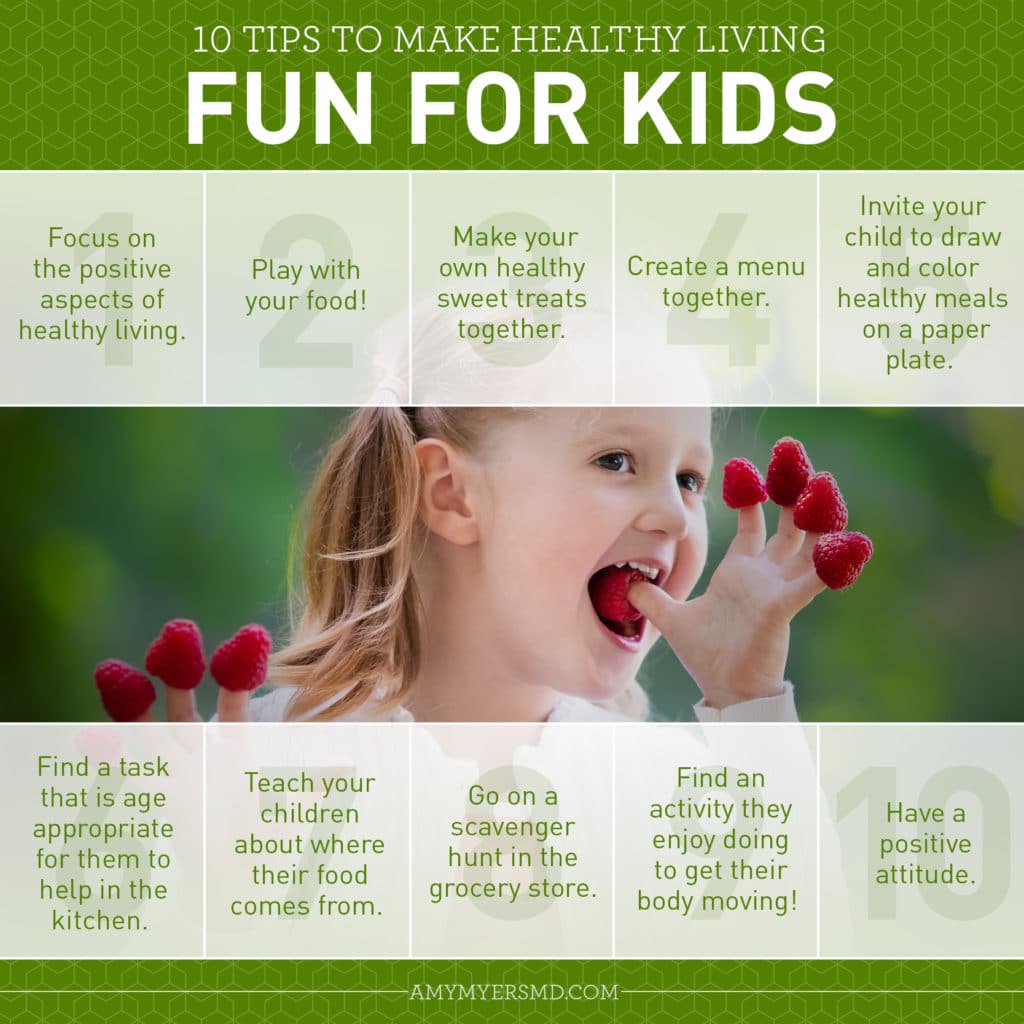When I was growing up, I was very blessed to have a mom who prioritized health. She exposed me to alternative medicine, yoga, and organic food at a very young age. She didn’t buy processed foods for me—instead, we made homemade yogurt and whole-wheat bread together, and we ate vegetables from our own garden. My mother shaped my appreciation for health as I got older and inspired my decision to become a doctor.
Whether you have children now, or are planning on having them in the future, you might be wondering how you can build a healthy foundation for them as they grow up. My Registered Dietitian came up with these great tips to make healthy living fun for kids so you can inspire them on the path to future health.
 Dr. Amy Myers
May 15th, 2015
https://content.amymyersmd.com/article/make-healthy-living-fun-for-kids/10 Tips To Make Healthy Living Fun For Kids – Infographic – Amy Myers MD®
Dr. Amy Myers
May 15th, 2015
https://content.amymyersmd.com/article/make-healthy-living-fun-for-kids/10 Tips To Make Healthy Living Fun For Kids – Infographic – Amy Myers MD®10 Tips to Make Healthy Living Fun for Kids
#1 Focus on the positive aspects of healthy living. Talk about the foods they CAN eat, the activities they CAN do, rather than telling them they can’t (I give this advice to my adult patients too!). It can be a challenge if your child has a food allergy or sensitivity, but you can empower your child to choose feeling healthy and good over feeling sick. Here are some great guidelines on how to tell if your child has a food sensitivity, and what to do about it.
#2 Play with your food! This can be a separate time from meal time to maintain whatever rules your family has around dinner, but there are so many creative things to do with vegetables – cauliflower sheep, cucumber frogs, tomato lady bugs, and carrot flowers. These foods won’t seem as scary if they have gotten to play with them.
Smoothies are another great option for kids. Let them pick the ingredients—each recipe is a different mix-and-match experiment. Here are three of my favorites!
If your children are finicky eaters, you can sneak some green vegetables into their smoothies. If your child is taking encapsulated supplements, but has a hard time swallowing pills, you could break the capsules up and put the contents in the smoothie to make them easier to take. You can also add a probiotic powder (which I think everyone, including children, should be taking on a daily basis–chewable probiotics are a favorite with my younger patients.) or protein powder. Some of the flavored protein powders like Paleo Protein Vanilla Bean are especially good for kids because you don’t have to do anything to them—just add almond milk, shake, and go!
#3 Make your own healthy sweet treats together. You can control what goes into homemade treats and avoid all those processed ingredients from the store. Try this recipe for gelatin “jigglers,” or these gluten-free, dairy-free peppermint brownie bites.
#4 Create a menu together. Let your child be involved in the family meal planning. This way there will be no surprises about what’s for dinner. This is a great opportunity to come up with some new recipes! Lay some guidelines and create a weekly menu with your children. Empower your children to make choices about what they put in their body—when they’re older, they’ll be able to plan healthy meals for themselves.
#5 Invite your child to draw and color healthy meals on a paper plate. Create guidelines about what they need to have, for example, 1 meat and 2 veggies, etc. This can inspire some great things in the kitchen.
#6 Find a task that is age appropriate for them to help in the kitchen. Your 3 year old can help get a vegetable out of the bottom drawer of your fridge and your 10 year old can be in charge of a side dish.
#7 Teach your children about where their food comes from. We get so used to seeing pre-packaged foods in the grocery store that we lose touch with where they actually came from! Take your children to a farmers’ market, grow a vegetable garden, or go strawberry picking at a local farm! All of these are fun family activities that will give your children a connection to their food.
#8 Go on a scavenger hunt in the grocery store. Make a list of things they are in charge of finding. Give them label-reading responsibilities so they can begin to learn about ingredients.
#9 Find an activity they enjoy doing to get their body moving! It’s no fun for kids to be active if they feel forced into an activity or a sport. Spend time as a family figuring out their interests and strengths to purse an activity they will be excited to do.
#10 Have a positive attitude. After all, your kids want to be just like you. If you show excitement in the kitchen, around trying new foods, and being active, they will too!
And last, but not least!
Model good behavior with frequent hand washing! Wash thoroughly with soap and warm water after using the toilet, before eating, before preparing food, and any time they’re dirty. Sing the alphabet song, or a family favorite while you lather up to make handwashing more fun. Cover your mouth when coughing and your nose when sneezing, ideally with the crook of your elbow. If you use your hands to do this, wash them as soon as possible. It’s one of the best things you can do to prevent the spread of germs and promote the health of your family and others around you.
